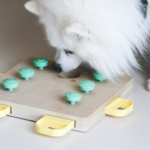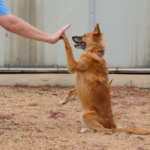Introduction
Dog parks and playdates are essential for your furry friend’s socialization and overall well-being. In this guide, we’ll explore the ins and outs of navigating these social environments, providing insights, and solutions for a positive and enjoyable experience for both you and your dog.
Understanding Dog Socialization
Socialization plays a pivotal role in shaping a well-rounded and adaptable canine companion. Introducing your dog to various environments, people, and fellow furry friends is not just a nicety but a crucial aspect of their overall well-being. Understanding the significance of socialization can pave the way for a harmonious relationship between your dog and the world around them.
Positive interactions with other dogs and humans contribute to a dog’s mental and emotional development. It fosters confidence, reduces anxiety, and helps them navigate different situations with ease. However, the journey towards successful socialization isn’t always without its challenges.
Some dogs may exhibit fear or aggression in unfamiliar settings, leading to potential difficulties during interactions. To address these challenges, gradual exposure is key. Start with controlled environments, allowing your dog to observe from a distance. Use positive reinforcement techniques, rewarding calm behavior and gradually decreasing the distance between them and new stimuli.
Dog parks and playdates offer valuable opportunities for socialization, but it’s essential to approach them with a strategic mindset. Monitor your dog’s body language and intervene if signs of stress or discomfort arise. Remember, every dog is unique, and the pace of socialization varies.
Choosing the Right Play Environment
Choosing the right dog park or arranging playdates for your furry friend involves thoughtful consideration to ensure a positive and safe experience. Several factors play a crucial role in creating an environment that fosters enjoyable social interactions for your dog.
First and foremost, safety should be a top priority. Opt for a dog park with secure fencing and well-maintained facilities. A properly enclosed space prevents your dog from wandering off and enhances their safety during play. Regular maintenance ensures a clean and hazard-free environment, minimizing the risk of injuries or health issues.
Consider the size and layout of the park. A spacious area allows dogs to roam and play freely without feeling cramped. Varied terrain and features, such as open fields, wooded areas, or agility equipment, contribute to a stimulating and engaging experience for your dog.
Compatibility among playmates is another crucial factor. Observe the dynamics between dogs and their owners, ensuring a positive and respectful atmosphere. A mix of sizes, energy levels, and play styles can enhance socialization opportunities, allowing your dog to interact with various companions.
For playdates, coordinate with other dog owners who prioritize a harmonious environment. Choose locations where dogs can meet on neutral ground before entering a home or backyard. This initial interaction helps gauge compatibility and reduce the chances of territorial behavior.
Addressing Challenges in Dog Parks
While dog parks are excellent spaces for canine socialization, they come with challenges that can impact the experience for both dogs and owners. Overcrowding, untrained dogs, and a lack of supervision are common issues that require proactive solutions.
Overcrowding in dog parks can lead to stressful situations, potentially causing conflicts among dogs. To address this, consider visiting during off-peak hours when there are fewer visitors. This not only reduces the chance of overcrowding but also provides a more relaxed environment for your dog to enjoy.
Untrained dogs can create challenges in a dog park setting. Not all dogs respond well to commands, and this lack of control can lead to disruptive behavior. To mitigate this, focus on basic obedience training for your dog before visiting the park. Establishing a solid recall command and reinforcing good behavior can contribute to a positive experience for everyone.
A key concern is the lack of supervision, which can result in uncontrolled interactions between dogs. One solution is for owners to actively supervise their pets and intervene if necessary. Additionally, collaborating with other responsible dog owners to maintain a watchful eye on the park can create a safer environment for all.
Establishing clear boundaries is essential. Ensure your dog respects the personal space of others, and be mindful of their comfort levels. If a dog exhibits aggressive or overly dominant behavior, have an exit strategy in place. Being prepared to leave the park if needed is crucial for the safety and well-being of all dogs involved.
Ensuring Positive Interactions
Social interactions among dogs can sometimes lead to behavioral issues such as aggression, fear, or excessive excitement. Understanding these issues and learning how to manage them is crucial for fostering positive socialization experiences.
Aggression is a common concern in dog socialization. It’s essential to recognize signs of aggression, such as growling, snapping, or rigid body language. If you notice these signals, it’s crucial to intervene promptly and separate the involved dogs to prevent escalation. Seek professional advice if aggression persists.
Fear is another challenge that may arise during social interactions. Some dogs may display fearful behavior, including cowering, trembling, or avoidance. In such cases, create a calm and controlled environment, gradually exposing the fearful dog to positive interactions at a comfortable pace. Patience and positive reinforcement can help build their confidence.
Excessive excitement can lead to unruly behavior and impact the overall dynamics of a play session. It’s important to monitor the energy levels of participating dogs. If excitement reaches a point where it becomes disruptive or potentially dangerous, consider redirecting their attention with toys or brief breaks.
Understanding dog body language is key to managing social interactions. Pay attention to cues like wagging tails, raised hackles, or relaxed postures. Intervene if you observe signs of discomfort or tension.
Conclusion
In conclusion, fostering positive social interactions for your dog requires careful consideration, preparation, and ongoing training. By understanding your dog’s needs and applying the suggested solutions, you can create enjoyable experiences at dog parks and playdates, enhancing your canine companion’s social skills and overall happiness.









